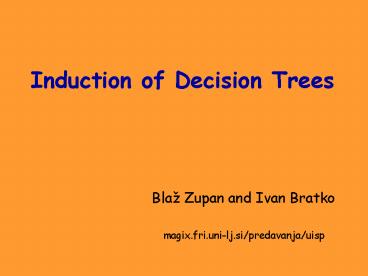Induction of Decision Trees - PowerPoint PPT Presentation
1 / 28
Title:
Induction of Decision Trees
Description:
sailboat. Classification. yes. no. yes. no. sunny. rainy ... sailboat. Induction of Decision Trees. Data Set (Learning Set) Each example = Attributes Class ... – PowerPoint PPT presentation
Number of Views:358
Avg rating:3.0/5.0
Title: Induction of Decision Trees
1
Induction of Decision Trees
- Blaž Zupan and Ivan Bratko
- magix.fri.uni-lj.si/predavanja/uisp
2
An Example Data Set and Decision Tree
3
Classification
outlook
sunny
rainy
yes
company
no
big
med
no
yes
sailboat
small
big
yes
no
4
Induction of Decision Trees
- Data Set (Learning Set)
- Each example Attributes Class
- Induced description Decision tree
- TDIDT
- Top Down Induction of Decision Trees
- Recursive Partitioning
5
Some TDIDT Systems
- ID3 (Quinlan 79)
- CART (Brieman et al. 84)
- Assistant (Cestnik et al. 87)
- C4.5 (Quinlan 93)
- See5 (Quinlan 97)
- ...
- Orange (Demšar, Zupan 98-03)
6
Analysis of Severe Trauma Patients Data
PH_ICU
gt7.33
lt7.2
7.2-7.33
Death0.0 (0/15)
APPT_WORST
Well0.88 (14/16)
lt78.7
gt78.7
Well0.82 (9/11)
Death0.0 (0/7)
PH_ICU and APPT_WORST are exactly the two factors
(theoretically) advocated to be the most
important ones in the study by Rotondo et al.,
1997.
7
Breast Cancer Recurrence
Degree of Malig
lt 3
gt 3
Tumor Size
Involved Nodes
lt 15
gt 15
lt 3
gt 3
no rec 125 recurr 39
recurr 27 no_rec 10
no rec 30 recurr 18
Age
no rec 4 recurr 1
no rec 32 recurr 0
Tree induced by Assistant Professional Interesting
Accuracy of this tree compared to medical
specialists
8
Prostate cancer recurrence
9
TDIDT Algorithm
- Also known as ID3 (Quinlan)
- To construct decision tree T from learning set S
- If all examples in S belong to some class C
Thenmake leaf labeled C - Otherwise
- select the most informative attribute A
- partition S according to As values
- recursively construct subtrees T1, T2, ..., for
the subsets of S
10
TDIDT Algorithm
- Resulting tree T is
Attribute A
A
v1
v2
vn
As values
T1
T2
Tn
Subtrees
11
Another Example
12
Simple Tree
Outlook
sunny
rainy
overcast
Humidity
Windy
P
high
normal
yes
no
P
N
P
N
13
Complicated Tree
Temperature
hot
cold
moderate
Outlook
Windy
Outlook
sunny
rainy
sunny
rainy
yes
no
overcast
overcast
P
N
P
P
Windy
Windy
Humidity
Humidity
yes
no
yes
no
high
normal
high
normal
P
N
N
P
P
Windy
P
Outlook
yes
no
sunny
rainy
overcast
P
N
N
P
null
14
Attribute Selection Criteria
- Main principle
- Select attribute which partitions the learning
set into subsets as pure as possible - Various measures of purity
- Information-theoretic
- Gini index
- X2
- ReliefF
- ...
- Various improvements
- probability estimates
- normalization
- binarization, subsetting
15
Information-Theoretic Approach
- To classify an object, a certain information is
needed - I, information
- After we have learned the value of attribute A,
we only need some remaining amount of information
to classify the object - Ires, residual information
- Gain
- Gain(A) I Ires(A)
- The most informative attribute is the one that
minimizes Ires, i.e., maximizes Gain
16
Entropy
- The average amount of information I needed to
classify an object is given by the entropy
measure - For a two-class problem
entropy
p(c1)
17
Residual Information
- After applying attribute A, S is partitioned into
subsets according to values v of A - Ires is equal to weighted sum of the amounts of
information for the subsets
18
Triangles and Squares
19
Triangles and Squares
Data Set A set of classified objects
.
.
.
.
.
.
20
Entropy
- 5 triangles
- 9 squares
- class probabilities
- entropy
.
.
.
.
.
.
21
Entropyreductionbydata setpartitioning
Color?
22
Entropija vrednosti atributa
.
.
.
.
.
.
red
Color?
green
yellow
23
Information Gain
.
.
.
.
.
.
red
Color?
green
yellow
24
Information Gain of The Attribute
- Attributes
- Gain(Color) 0.246
- Gain(Outline) 0.151
- Gain(Dot) 0.048
- Heuristics attribute with the highest gain is
chosen - This heuristics is local (local minimization of
impurity)
25
red
Color?
green
yellow
Gain(Outline) 0.971 0 0.971 bits Gain(Dot)
0.971 0.951 0.020 bits
26
red
Gain(Outline) 0.971 0.951 0.020
bits Gain(Dot) 0.971 0 0.971 bits
Color?
green
yellow
solid
Outline?
dashed
27
red
.
yes
Dot?
.
Color?
no
green
yellow
solid
Outline?
dashed
28
Decision Tree
.
.
.
.
.
.
Color
red
green
yellow
Dot
Outline
square
yes
no
dashed
solid
square
triangle
square
triangle































